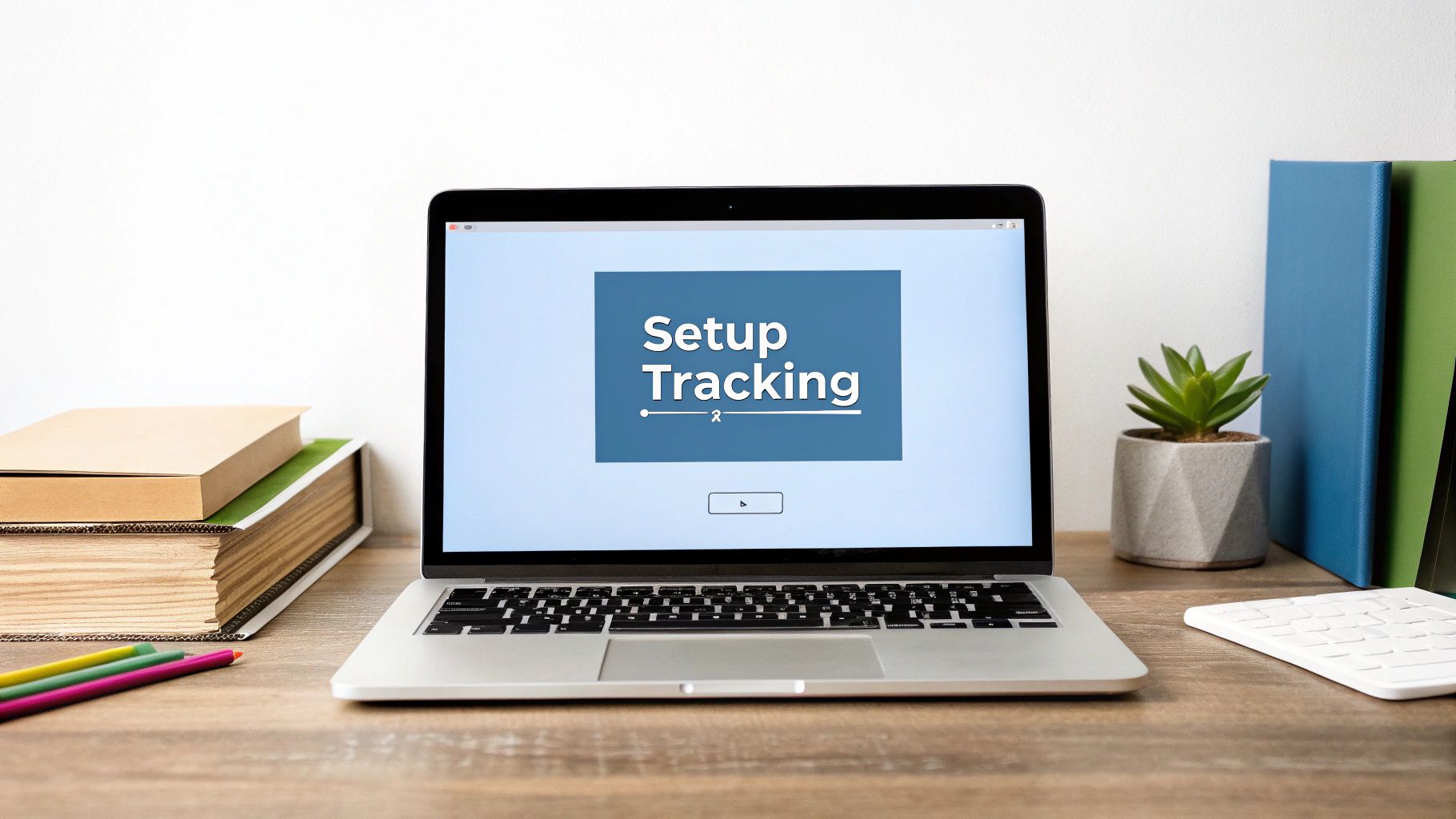
How to Track Keyword Rankings Like a Pro
Share
Keeping an eye on your keyword rankings is all about using SEO tools to see where your site shows up on Google for the terms that matter most. This isn't just about stroking your ego; it's how you get the real story on your SEO performance, see what competitors are up to, and measure if your hard work is actually paying off.
Why Keyword Rank Tracking Is Still a Big Deal in SEO

With all the complex analytics dashboards out there, just watching keyword positions might feel a little old-school. But trust me, it’s still a fundamental piece of any smart SEO strategy. Think of it as your digital early-warning system.
Consistent rank tracking is often the first place you'll notice the effects of a Google algorithm update or a competitor making a big push. It gives you the cold, hard data you need to justify your SEO efforts, drawing a direct line between your actions and your visibility in search results.
A Clear-Cut Measure of SEO Impact
Keyword rankings are beautifully straightforward. When you see your target keywords climbing, you know your strategy is on the right track. This kind of data is gold when you're reporting back to stakeholders and trying to show the ROI of your SEO budget.
And let's be real, higher rankings aren't just for show. They directly lead to more clicks and more visitors.
For a restaurant equipment business, this means seeing your "commercial convection oven" page jump from the obscurity of page three to the front page. That single move can have a massive impact on your leads. Understanding these shifts is the first step in figuring out what really drives your organic traffic. For a deeper look, check out our guide on what is organic traffic and why it's so critical.
Tracking isn't about vanity metrics; it’s about understanding search trends and audience behavior to make smarter, proactive decisions for your content and overall strategy.
Staying Ahead in a Crowded Digital World
Over the last ten years, tracking keyword rankings has become non-negotiable in digital marketing. Fast forward to 2025, and the competition is just nuts—we're talking over 99,000 Google searches happening every single second.
Keeping a close watch on your positions gives you a serious edge. It helps you spot opportunities and threats in real-time, which is essential in such a fast-paced environment. You can find more fascinating stats like this in these powerful SEO statistics on Keyword.com.
Choosing Your Keyword Tracking Toolkit
Picking the right tool to track your keyword rankings can feel overwhelming, but it boils down to what you actually need. Forget the flashy feature lists for a minute. Your goal is to find a platform that delivers accurate, timely data without blowing your budget.
What matters most? You need reliable data accuracy, frequent updates (daily is the gold standard, weekly is the bare minimum), and a solid competitor analysis feature. Seeing where your own site ranks is only half the story. To really get ahead, you have to know who you're up against and how they're performing on the same keywords.
Finding the Right Fit for Your Budget
The good news is the market is full of options, so there’s something for every business size and budget. You don’t need to spend a fortune to get started.
- Free Tools: Everyone should be using Google Search Console. It’s non-negotiable. However, it only shows you average positions over time, which can easily hide a sudden, disastrous drop or a big win. Think of it as a great starting point, but you’ll need to pair it with something more precise.
- Freemium & Paid Platforms: This is where the real power lies. You get daily updates, historical data going back months or years, and the deep competitive insights you need to make smart decisions. To dig into what's out there, you can explore some of the best keyword rank checking tool options currently on the market.
Ultimately, the right tool depends on your scale. A local restaurant equipment shop might do just fine with a solid free or low-cost plan. A national e-commerce player, on the other hand, will absolutely need the robust, daily data that comes with a paid subscription.
Feature Comparison of Popular Rank Tracking Tools
To help you visualize the differences, here’s a quick breakdown of what you can generally expect from each category of tool. This isn't exhaustive, but it gives you a good sense of the trade-offs.
| Feature | Free Tools (e.g., Whats My SERP) | Freemium Tools (e.g., Semrush Free Tier) | Paid Tools (e.g., Ahrefs, Moz Pro) |
|---|---|---|---|
| Data Accuracy | Generally reliable for spot checks | High accuracy, but with limits | Highest accuracy, verified data |
| Update Frequency | Manual or limited daily checks | Limited daily or weekly updates | Daily (or even on-demand) updates |
| Number of Keywords | Very limited (e.g., 10-25) | Limited (e.g., 10-50) | High volume (hundreds to thousands) |
| Competitor Tracking | Basic or non-existent | Limited to 1-3 competitors | Comprehensive, multiple competitors |
| Historical Data | None or very limited | Limited retention (e.g., 30 days) | Extensive, long-term history |
| Reporting & Alerts | Basic manual exports | Basic automated reports | Advanced, customizable reports & alerts |
As you can see, paid tools offer a much deeper and more actionable set of features. While free tools are great for getting your feet wet, a serious SEO strategy will quickly outgrow them.
Once you’ve picked your tool, the actual process is pretty straightforward.

This simple workflow—select your keywords, configure the tracking, and review the data—is the core of any successful monitoring strategy. It doesn't matter what software you use; the principles are the same.
The most important thing is to just get started. Honestly, tracking even a handful of your most important keywords will give you more insight than tracking none at all. Consistency is what really moves the needle.
Setting Up Your First Tracking Project

Alright, you've picked your tool. Now for the fun part: getting your hands dirty. Setting up your first project correctly is more than just busywork—it’s the foundation for all the data you’ll use to make smart decisions down the road.
First things first, you need to load in your keywords. The biggest rookie mistake I see is dumping in hundreds of generic terms, hoping something sticks. A smaller, focused list is always more powerful. A great starting point is understanding how to use Google Search Console to see what keywords you're already getting impressions for.
Here's a pro tip: For each important page on your site—say, a category page for "commercial refrigerators" or a blog post on "how to clean a deep fryer"—track one main keyword and maybe two to four close variations. This keeps your data clean and actionable.
Defining Your Tracking Parameters
With your initial keyword list ready, the next step is dialing in the tracking settings. Don't just fly through these default options. The details here determine whether your reports are accurate or just noise.
This is especially critical if you have physical locations or a defined service area. You need to configure a few key things:
- Search Engine and Language: Make sure you're tracking the right Google version (like google.com vs. google.ca) and language. It seems obvious, but it's an easy mistake to make.
- Location: This is a big one. If you’re a supplier in Dallas, you care about your rankings in the Dallas-Fort Worth metroplex, not what’s happening nationally. Get specific.
- Device Type: You absolutely have to track both desktop and mobile. With mobile search making up over 60% of all searches, you'd be surprised how different the results can be.
Once those settings are locked in, add one final layer of organization: tags or groups. This is a lifesaver as your keyword list expands. I like to group keywords by product line ("cooking equipment," "refrigeration") or by search intent ("informational," "transactional").
This kind of structure is a core principle of good SEO project management. It turns a simple list of keywords into a strategic tool that actually tells you a story.
How to Analyze Your Keyword Ranking Data
Having a list of keyword rankings is great, but that data is useless until you learn how to read between the lines. The real skill is in connecting those numbers to what's actually happening with your SEO efforts.
Simply watching a keyword move up or down doesn't tell you much. The moment a rank changes, you should be asking why. Did we just push a content update to that page? Did a competitor launch a huge new resource? Was there a whisper of a Google algorithm update? That’s where the real insights are found.
Moving Beyond Simple Rank Position
A single number for a keyword position is just a snapshot, and it's missing all the context. To get a clear picture of your SEO health, you need to look at a few different metrics together.
- Search Visibility Score: Most good rank trackers offer this. It’s basically your estimated market share in the search results for the keywords you’re tracking. It weighs your rank against the search volume for each term, giving you a fantastic high-level view of whether you're gaining or losing ground.
- Estimated Traffic: This is the metric that connects your rankings to real business results. It estimates the clicks you’re getting based on your position, which is a powerful way to show the ROI of your SEO work.
- SERP Features: Are you earning the Featured Snippet for a key informational term? Or showing up in the Local Pack for "restaurant supply near me"? These features often dominate the top of the page and can drive a massive amount of traffic. Not tracking them means you're missing a huge piece of the puzzle.
Diagnosing Ranking Fluctuations
Let's be clear: not all ranking changes are a five-alarm fire. You have to learn to separate the everyday noise from the signs of a genuine problem.
If one low-volume keyword bounces around a few spots, I usually don't lose sleep over it. But if a whole group of related keywords suddenly plummets? That's when I drop everything. That kind of pattern often points to a technical problem, like a page being de-indexed, or a penalty from a recent algorithm update.
A high-value "money" keyword like "commercial ice machine for sale" dropping from position 3 to 11 is an all-hands-on-deck situation. You need to immediately audit that page: check the on-page SEO, see who the new competitors are on page one, and review your internal linking.
Watching how keyword rankings evolve is more critical than ever. For example, by 2025, it's estimated that only about 5.8% of searches will show a Featured Snippet. But when they do appear, those coveted spots can steal up to 42.9% of all clicks. This shows just how valuable it is to track your presence in these features.
And with 75% of searchers never clicking past the first page, consistently keeping an eye on your positions is non-negotiable. If you want to dive deeper, you can explore more fascinating SEO statistics that really show how high the stakes are.
Turning Ranking Insights Into Actionable Strategy

Okay, this is where the real work begins. You've got the data, now it's time to turn those numbers into actual SEO growth. A solid strategy is what separates passive monitoring from proactive, meaningful action, letting you use your tracking insights to decide what to tackle next.
Think of your rank tracking tool less like a report card and more like a treasure map. It's designed to show you exactly where the most valuable opportunities are—both for quick wins and for steady, long-term gains.
The ultimate goal is to build a smart feedback loop. Your tracking data should directly inform your content strategy, your link-building priorities, and your technical fixes, creating a cycle of continuous improvement.
Prioritize Your Low-Hanging Fruit
One of the smartest first moves is to go after your "low-hanging fruit." These are the keywords where you're almost there—already ranking on the second page of Google, usually in positions 11-20.
If you have a page sitting at position 12 for "commercial pizza oven financing," Google already sees it as relevant. It just needs a little nudge to break onto page one, where the real clicks happen. A few focused tweaks can often do the trick:
- Refresh the on-page content. Does it truly answer what the searcher is looking for?
- Strengthen your internal linking. Find other relevant pages on your site and point more links to this one.
- Build a couple of high-quality backlinks. A little boost in authority can make all the difference.
For a full rundown of what to look for, our restaurant equipment SEO cheat sheet gives you a structured checklist to work from.
Uncover and Exploit Content Gaps
Your rank tracker is also your best tool for competitive reconnaissance. When you notice a competitor consistently beating you for a whole group of valuable keywords, it’s a clear signal to dig into what they're doing right.
Pull up their top-ranking page and analyze it. What topics are they covering that you've missed? Do they offer a more detailed guide, a helpful calculator, or better product photos? This process will shine a spotlight on content gaps in your own strategy.
By building a resource that's more comprehensive and genuinely more helpful, you can directly challenge their top spot and start pulling in that traffic for yourself. It’s a proactive way to turn a competitor's success into your next content idea.
A Few Common Questions About Keyword Tracking
As you start digging into keyword tracking, a few questions inevitably surface. I've heard these from clients time and time again, so let's clear them up right now.
How Often Should I Be Checking My Keyword Rankings?
For most businesses in this space, checking your rankings weekly hits the sweet spot. It's frequent enough to catch any big shifts from a Google update or a competitor making a move, but not so often that you get lost in the day-to-day noise.
Of course, there are exceptions. If you're launching a new product line or going after some hyper-competitive terms like "commercial combi oven," you might want to switch to daily tracking for a bit. This gives you a much faster feedback loop on what's working.
Why Do My Rankings Look Different Than What My Tool Shows?
This one is simple: trust your tool.
When you search for something on Google, the results are tailored specifically for you. Google considers your physical location, your past search history, and even the device you're on.
A good rank tracking tool strips all of that away. It gives you an objective, standardized view from a specific location, which is the only reliable way to measure your actual SEO performance. Your own manual searches are just too biased to be useful for analysis.
What Exactly Is Keyword Cannibalization?
Think of it like this: you have two different salespeople from your company trying to sell the same product to the same customer. It just creates confusion.
Keyword cannibalization is the digital version of that. It happens when multiple pages on your own website are all trying to rank for the same keyword. A rank tracker will flag this when you see two of your own URLs constantly flip-flopping in the search results for the same term. This tells Google you don't have one clear, authoritative page on the topic, and that can drag both pages down.
Ready to stop guessing and start turning your ranking data into actual growth? The team at Restaurant Equipment SEO lives and breathes this stuff. We build strategies that drive real business results. Find out more at https://restaurantequipmentseo.com.